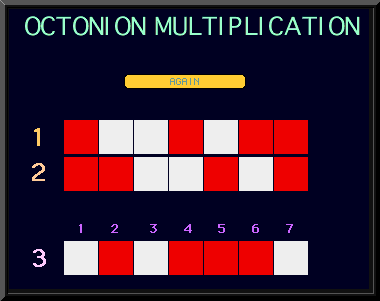

In July 1994, Geoffrey Dixon's book
Division Algebras: Octonions, Quaternions, Complex Numbers, and the Algebraic Design of Physics
was published by Kluwer (ISBN: 0-7923-2890-6)
(see clf-alg/dixo9401 on the Clifford Algebra bulletin board):
Abstract: The four real division algebras (reals, complexes, quaternions and octonions) are the most obvious signposts to a rich and intricate realm of select and beautiful mathematical structures. Using the new tool of adjoint division algebras, with respect to which the division algebras themselves appear in the role of spinor spaces, some of these structures are developed, including parallelizable spheres, exceptional Lie groups, and triality. In the case of triality the use of adjoint octonions greatly simplifies its investigation. Motivating this work, however, is a strong conviction that the design of our physical reality arises from this select mathematical realm. A compelling case for that conviction is presented, a derivation of the standard model of leptons and quarks.
Table of contents: I Underpinnings 1.1 The Argument 1.2 Clifford Algebras 1.3 Conjugations and Spinors 1.4 Algebraic Fundamentals of the Standard Model II Division Algebras Alone 2.1 Mostly Octonions 2.2 Adjoint Algebras 2.3 Clifford Algebras, Spinors 2.4 Resolving the Identity of OL 2.4 Lie Algebras, Lie Groups, from OL 2.5 From Galois Fields to Division Algebras: An Insight III Tensor Algebras 3.1 Tensoring Two: Clifford Algebras and Spinors 3.2 Tensoring Two: Spinor Inner Product 3.3 Tensoring Three: Clifford Algebras and Spinors 3.4 Tensoring Three: Spinor Inner Product 3.5 Derivation of the Standard Symmetry 3.6 SU(2)xSU(3) Multiplets and U(1) IV Connecting to Physics 4.1 Connecting to Geometry 4.2 Connecting to Particles 4.3 Parity Nonconservation 4.4 Gauge Fields 4.5 Weak Mixing 4.6 Gauging SU(3) V Spontaneous Symmetry Breaking 5.1 Scalar Fields 5.2 Scalar Lagrangians 5.3 Fermions and Scalars VI 10 Dimensions 6.1 Fermion Lagrangian 6.2 More SU(3) 6.3 Freedom from Matter/antimatter Mixing 6.4 (1,9)-Scalar Lagrangian 6.5 Charge Conjugation on TL(2) 6.6 Charge Conjugation on T2 6.7 10 Other Dimensions VII Doorways 7.1 Moufang and Other Identities 7.2 Spheres and Lie Algebras 7.3 Triality 7.4 LG2 and Tri 7.5 LG2 and the X-Product VIII Corridors 8.1 Magic Square 8.2 The Ten MS(KK') 8.3 Spinor(KK') Outer Products 8.4 LF4 = MS(RO) 8.5 J(3,O) and F4 8.6 More Magic Square
Dixon's papers include:
Division Algebras, Galois Fields, Quadratic Residues hep-th/9302113
Division Algebras, (1,9)-Space-Time, Matter-antimatter Mixing hep-th/9303039
Octonion X-product Orbits hep-th/9410202
Octonion X-product and Octonion E8 Lattices hep-th/9411063
Octonions: E8 Lattice to /\16 hep-th/9501007
Octonion XY-Product hep-th/9503053
Octonions: Invariant Representation of the Leech Lattice hep-th/9504040
OCTONIONS: INVARIANT LEECH LATTICE EXPOSED hep-th/9506080
Octonion X,Y Product G2 Variants hep-th/9604116
Division Algebras: 26 Dimensions; 3 Families hep-th/9902016
(1,9)-spacetime to (1,3)-spacetime: Reduction to U(1)xSU(2)xSU(3) hep-th/9902050
Algebraic Spinor Reduction Yields the Standard Symmetry and Family Structure
Tensored Division Algebras: Resolutions of the Identity and Particle Physics
As I understand it, the starting point is M(64,C) = Cl(12,1) with 2^13 = 2^6 x 2^6 x 2 = 64x64x2 = 8,192 real dimensions, and whose graded structure is
1 13 78 286 715 1287 1716 1716 1287 715 286 78 13 1
and whose bivector Lie algebra is 78-dimensional Spin(12,1), a non-euclidean version of Cl(13).
Another 78-dimensional algebra is E6, which has a 32-dim Hermitian Symmetric Space (I'll call it HSS32) such that
so that 78-dim E6 breaks down into 32-dim and (45+1)-dim.
HSS32 has complex structure, so it is really a 16-complex-dim space, and in fact is just the 32-dim spinor space of the Cl(10) Clifford algebra of Spin(10).
Do the 16 complex dimensions of HSS32 correspond to the 16 orthogonal subspaces of the form Tmn+Tmn of Geoffrey Dixon's decomposition of your Cl(13) spinor space T+T, the space of 2x1 column matrices over T = CxQxO ?
From Geoffrey Dixon's point of view, it looks like he is looking at Cl(12,1) in terms of the Cl(9,1) spinors, and
from my point of view, it looks like you could also (if you changed the multiplication table somewhat) build E6 from Cl(9,1) and its spinors.
Since the chain E6 -> D5 -> D4 is the basis of the VoDou D4-D5-E6-E7 physics model, it would be nice to write it in terms of
where Cl* is something like (but maybe not exactly) a Clifford algebra.
Putting in non-Euclidean signature ought to be straightforward, I think.
and
HERE is my rough attempt to combine Dixon's approach with Kenichi Horie's Geometric Interpretation of Electromagnetism in a Gravitational Theory with Torsion and Spinorial Matter.
...
...